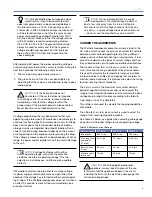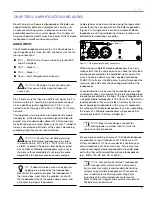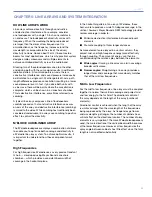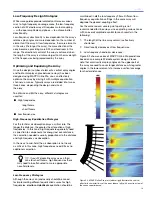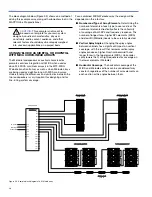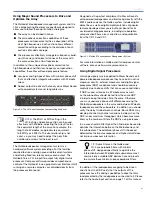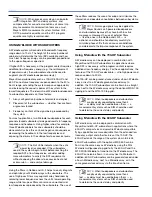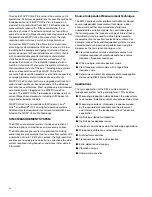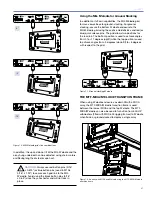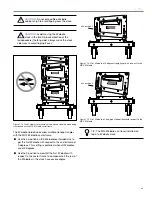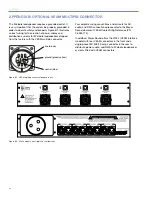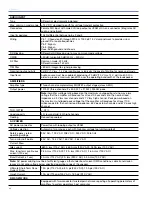
21
CHAPTER 5
Using Meyer Sound Processors to Drive and
Optimize the Array
The Galileo 616 loudspeaker management system and the
LD-3 compensating line driver are specifically designed to
allow you to follow these optimization strategies:
■
The array can be divided in zones.
■
The atmospheric correction capabilities of these
processors compensates for the air absorption of the
air at high frequencies. Each section allows different
correction settings according to the distance of each
section’s intended coverage.
■
The processors effectively manage low-frequency build-
up in the array and correct all zones of the array with
the same correction at low frequencies.
In addition to their unique atmospheric correction for
high frequencies and their low-frequency compensation
capabilities, these Meyer Sound processors feature:
■
Low-pass and high-pass filters with minimal phase shift
that can effectively integrate subwoofers with M’elodie
arrays.
■
Robust output line drivers that easily drive Meyer Sound
self-powered systems over long cable runs.
Figure 5.4.
The LD-3 air attenuation compensating line driver
NOTE:
The MILO or M1D setting in the
LD-3’s Array Correction section can be used
effectively with M’elodie, adjusting the Array Size for
the equivalent length of the array. For example, the
length of 6 M’elodies is approximately equivalent
to 8 M1Ds or 4 MILOs. The size relationship is not
exact, so you may need to adjust the Array Size
number up or down for the best result.
The Galileo loudspeaker management system is a
hardware/software system providing all of the facilities
required to drive and align sound reinforcement systems,
and offering fixed low latency across each output. The
Galileo 616 is a 2U, 6-input/16-output fully digital matrix
processor. Compass software provides comprehensive
control of the Galileo 616 via a graphical user interface (GUI)
running on a remote computer, or controlled directly from
the processor front panel.
Designed as the perfect complement to Meyer Sound’s
self-powered loudspeakers and interfacing directly with the
SIM 3 audio analyzer, the Galileo system includes digital
delay lines as well as digital implementations of popular
features developed over years by Meyer Sound for its
acclaimed analog processors, including air absorption
compensation filters, array correction, and equalization
from the CP-10 and VX-1.
Figure 5.5.
Galileo 616 Loudspeaker Management System
For more information on Galileo and its Compass control
software, please visit www.meyersound.com.
Using Digital Signal Processors
Full-range signals may be applied to Meyer Sound’s self-
powered loudspeakers because they have built-in active
crossover circuits; external crossovers and digital signal
processors (DSP) are optional and should be used very
carefully due to phase shifts that can cause cancellations.
If DSP is used, all zones in a M’elodie array as well
as the subwoofers should be fed from the same DSP
in order to keep their delay time the same. Otherwise
you may experience phase shift differences among the
M’elodie loudspeakers in the array and between M’elodie
loudspeakers and the subwoofers. In addition, you should
verify the delay time between channels: Some DSPs may
develop channel-to-channel variations in delay when the
DSP is near maximum throughput, which becomes more
likely as the number of filters the DSP is using increases.
In no case should a filter higher than 2nd order be used to
optimize the interaction between the M’elodie array and
the subwoofers. The additional phase shift introduced
deteriorates the impulse response and higher roll-off does
not improve crossover interaction.
TIP:
Some filters on the Galileo and
LD-3 are parabolic filters with minimal
phase shift, designed specifically to optimize the
interaction between M’elodie and subwoofers; most
commercially available DSP devices have no presets
to emulate these minimum-phase parabolic filters.
In addition, if the loudspeakers are going to be driven
directly from the DSP, verify that the outputs of the
processor have the driving capabilities to drive the total
load presented by the loudspeakers connected to it. Please
refer to the Audio Input section on page 11 of this manual.
Summary of Contents for M'elodie
Page 8: ...2 INTRODUCTION ...
Page 20: ...14 CHAPTER 3 ...
Page 42: ...36 APPENDIX C ...
Page 43: ......



